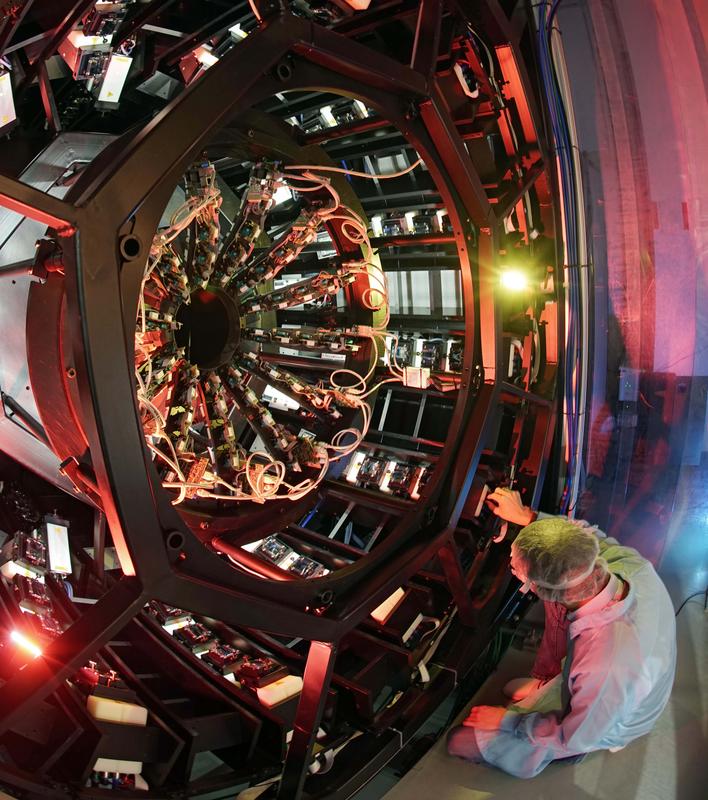Jena Laser System Sets a Further World Record

POLARIS at the University of Jena is the world's most powerful fully diode-pumped laser system. Now physicists succeeded to improve POLARIS' performance significantly. Photo: Jan-Peter Kasper/FSU
POLARIS is the world's most powerful fully diode-pumped laser system and with it, the University of Jena possesses a petawatt-class laser, which produces the presently highest-performing laser pulses.
A team of physicists under the leadership of Prof. Dr Malte Kaluza at the Institute of Optics and Quantum Electronics has now succeeded to once again improve POLARIS' performance significantly. For the first time, the laser has produced pulses delivering an energy of more than 50 Joule, which is more than three times as high as before.
50 Joule is the amount of energy needed to lift an object weighing 500 g approximately 10 m off the ground; to raise the temperature of a glass of water by only one degree, however, 17 times as much energy would be required. For a high-performance laser system like POLARIS, 50 Joule therefore seems rather meagre.
„But our laser system delivers this amount of energy in a very short time interval,“ explains Prof. Kaluza. The laser pulses have a duration of 120 femtoseconds only. In this unimaginably brief moment – a femtosecond is one thousand-million-millionth of a second –, the laser reaches a peak power of several hundred terawatts (TW). This is many times higher than all the electrical power produced worldwide.
This increase in the laser system’s performance is the result of several months of development. „The basic architecture and set-up of the laser have not changed,“ underlines Prof. Kaluza, „but we succeeded in changing and improving many small details decisively.“
The recent results and achievements were also made possible through a long-term cooperation with the local optics industry – in particular with the Jenoptik AG, with Lastronics GmbH, with Hellma Materials GmbH, and with Layertec GmbH –, who have provided some of the core components of the laser system. For example, the last and largest power amplifier of POLARIS now uses ytterbium-doped calcium fluoride crystals.
And also the optical coating of the materials put under enormous stress by the laser radiation has been further optimized. „All these small changes together now allow us to reach a considerably higher laser energy than before,“ explains Kaluza. But the laser physicist also suggests that the 54.16 Joule reached now are far from being the finish line.
As the next stage in the development, Kaluza, who also is the holder of the chair of experimental physics and relativistic laser physics, now plans to shorten the duration of pulses in the POLARIS system even further, the goal being to reduce the duration to no more than 100 femtoseconds. The steady reduction of the duration is, however, not a goal in itself.
„We are not looking to always set new records,“ explains Kaluza. On the contrary, the objective is to make POLARIS available for specific uses. First and foremost, the laser is meant to be used as a tool for particle acceleration. „We have already conducted some first experiments in this field with lower pulse energy and longer laser pulses. Now we are excited to see how the particle energy will scale with the much higher laser energy and concurring shorter pulse duration.“
Intense and highly energetic ion radiation can, for example, be used in tumour treatment. So far, the generation of these highly energetic particles required tremendous technical efforts in very large particle accelerators.
„With the amount of energy we are now able to generate, we can offer laser systems like POLARIS for particle irradiation, which are comparatively ‘easy to handle’ and manageable. We are now curious to see to what particle energy we can now make it with the new laser pulses,“ says Prof. Kaluza.
Information on POLARIS:
The name POLARIS stands for „Petawatt Optical Laser Amplifier for Radiation Intensive Experiments.“ The project in the framework of which POLARIS was developed was launched at the University of Jena in 1999. The laser has been continuously developed ever since and currently is the world’s only fully diode-pumped laser system generating pulses with a peak power of more than 200 TW and can thus be used for high-intensity experiments. More information at: https://www.hi-jena.de/en/helmholtz_institute_jena/experimental_facilities/local…
Contact:
Prof. Dr Malte Christoph Kaluza
Institute of Optics and Quantum Electronics of the University of Jena
Max-Wien-Platz 1, 07743 Jena, Germany
Helmholtz Institute Jena, Fröbelstieg 3, 07743 Jena, Germany
Phone: +49 (0) 3641 / 947280
E-mail: malte.kaluza[at]uni-jena.de
Media Contact
All latest news from the category: Physics and Astronomy
This area deals with the fundamental laws and building blocks of nature and how they interact, the properties and the behavior of matter, and research into space and time and their structures.
innovations-report provides in-depth reports and articles on subjects such as astrophysics, laser technologies, nuclear, quantum, particle and solid-state physics, nanotechnologies, planetary research and findings (Mars, Venus) and developments related to the Hubble Telescope.
Newest articles

NASA: Mystery of life’s handedness deepens
The mystery of why life uses molecules with specific orientations has deepened with a NASA-funded discovery that RNA — a key molecule thought to have potentially held the instructions for…

What are the effects of historic lithium mining on water quality?
Study reveals low levels of common contaminants but high levels of other elements in waters associated with an abandoned lithium mine. Lithium ore and mining waste from a historic lithium…

Quantum-inspired design boosts efficiency of heat-to-electricity conversion
Rice engineers take unconventional route to improving thermophotovoltaic systems. Researchers at Rice University have found a new way to improve a key element of thermophotovoltaic (TPV) systems, which convert heat…



